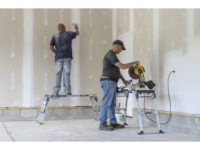Where Eagles Dare
A Colorado-Based EIFS Contractor Is Ready To Retire. So Who Wants To Purchase The Brand?


















An Eagle, Colo., outfit has its own dilemma this year—to sell or not to sell. And those notions constitute what it means to measure all aspects of business and whether it makes sense to continue or to retire. So what does it mean in this day and age to sell one’s company?
Synthetic Sidings Inc. might offer some insights to what this means for a successful EIFS contractor. The company does installation and repair of EIFS and traditional stucco, in addition to exterior installation of rubberized deck coating—a niche service the husband and wife CEOs Vance and Melissa Carroll offer in its local Colorado region. But after 35 years, the team has decided to take a new approach.
The company headed by the team of Vance and Melissa has successfully installed, serviced and contracted some very impressive Colorado landmarks. Yet in their senior years, the couple has considered maybe it’s time to walk away from it. Is this the right time?
“I learned to run a trowel by working for a swimming pool company,” says Vance Carroll. “Shortly after arriving in Denver, I answered an ad for stucco applicators requiring a 240-mile daily commute. After five weeks of that, we moved up to the mountains and four years later we bought the company I was working for, changing its name to Synthetic Sidings Inc.”
How it Began
As Melissa describes her first years in the trade, the company’s possession of EIFS certification and insurance added to the expertise acquired through many years of practicing and teaching. Synthetic Sidings enjoyed a welcomed and profitable niche in the constant repairs of so many upscale hotels and venues that have needed to always look their best.
The extreme mountain weather conditions have management companies keeping their number on speed-dial. During the majority of the past 35 years, only one other company in the four counties the company services carries EIFS insurance.
And how is business now? “Frankly, underserved,” says Vance. “Issues plaguing the rest of the country exist here too. The shortage of qualified help or people willing and desiring to learn construction skills is a factor in the ability to man the workforce.”
According to the Carrolls, there has been a steady increase in building—especially in the employee housing area; an area that had been neglected for a long time they say. As Vance explains, working pretty much exclusively in the “time-plus materials” section of EIFS/stucco repair was a win-win situation for Synthetic Sidings and the company has not counted on any of the growth (i.e. building of multi-family units or condominiums) and still, has done well. Colorado—in particular Eagle County—is somewhat insulated from America’s present financial stress. Vance says it is worth mentioning that only once in the company’s 35 years has Synthetic Sidings not been paid.
Time to Move On
For many companies, the time may seem right to consider an exit strategy. The reasons for this may vary but after these are considered and weighed, a point may come to where a company may need or want to sell.
In the Carroll’s case, this time has come. In Synthetic Sidings situation, retirement seems to be the deciding factor. The husband and wife duo have shown that the company they formed has been a success. But now they’ve decided it’s time to leave. The Carrolls say that after owning the business for the last 35 years, the husband and wife feel it’s time to relinquish control has become the obvious next step.
“The estimating portion of the bidding” seems to be the biggest drag for the Carrolls. “With demolition and repair being the niche, often the largest portion of the work is not apparent (water damage, mold remediation) and yet you want to be as above board as possible with the client,” says Vance.
Colorado has some of the more rigid building regulations in the country, says Melissa. “Skilled craftsmen are getting more difficult to find in all parts of the country and after concentrating on the ‘one foot in front of the other’ approach, we find that we are in a comfortable position … to rest and focus on the more personal aspects of living.
“We have terrific relationships and many repeat customers because of the detailed communication, as well as the aesthetically pleasing results of our ‘no-stone unturned’ repairs,” she continues. “We are blessed to live in such a community where we have an appreciated skill to share and a clientele who wants it done right.”
The Carrolls have had a great go, creating a successful business in an area with plenty of money to go around. The company is looking for a suitable fit, most likely from a competing or neighboring wall and ceiling contractor.
Their goal is pretty simple: to retire comfortably and get a fair market value for Synthetic Siding. The Carrolls have every intention of remaining in their area.
“We want to sell our business to a qualified, ethical, EIFS-experienced individual or existing company—as we sincerely care for our clients and their property,” says Vance.
The Project That Changed Things
According to the Carrolls, the project that launched the company was The Charter in Beaver Creek (as seen on the cover). This building is the largest wood-framed building under one roof in America. Fifteen years into the life of Synthetic Sidings, the company worked on the project with a well-known architectural/engineering firm who had the power to approve any contract deviations, design the degree and method, after consulting with Synthetic Sidings and the Sto Corp. representatives.
The scope of the project consisted of 130,000 square feet of EIFS exterior:
- Repair areas of water and snow/ice damage
- Improve or replace flashing
- Upgrade building envelope to the latest Sto products
- Installation of 22,000 linear feet of Sto Sonoborn
- Application of 130,000 square feet of two coats of Sto Silcolastic paint with rollers
Looking for a reprint of this article?
From high-res PDFs to custom plaques, order your copy today!

















